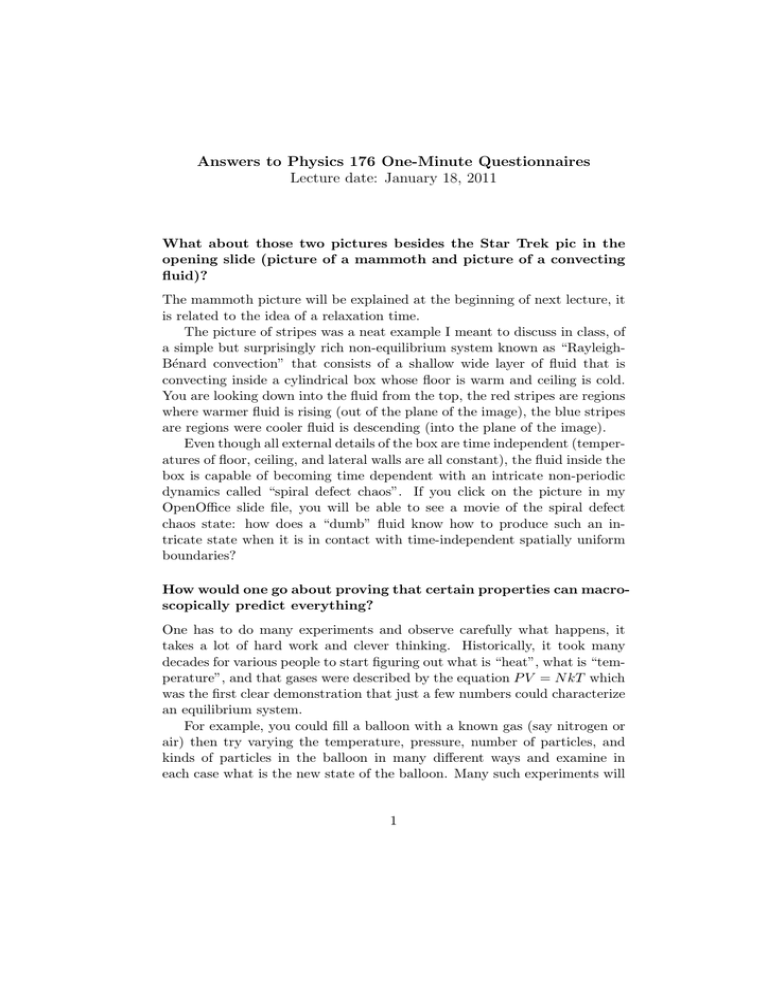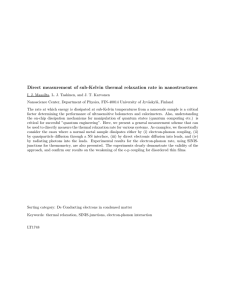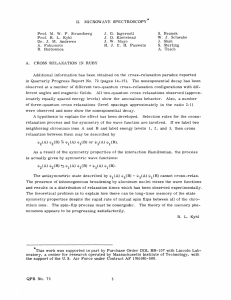Answers to Physics 176 One-Minute Questionnaires Lecture date: January 18, 2011
advertisement

Answers to Physics 176 One-Minute Questionnaires Lecture date: January 18, 2011 What about those two pictures besides the Star Trek pic in the opening slide (picture of a mammoth and picture of a convecting fluid)? The mammoth picture will be explained at the beginning of next lecture, it is related to the idea of a relaxation time. The picture of stripes was a neat example I meant to discuss in class, of a simple but surprisingly rich non-equilibrium system known as “RayleighBénard convection” that consists of a shallow wide layer of fluid that is convecting inside a cylindrical box whose floor is warm and ceiling is cold. You are looking down into the fluid from the top, the red stripes are regions where warmer fluid is rising (out of the plane of the image), the blue stripes are regions were cooler fluid is descending (into the plane of the image). Even though all external details of the box are time independent (temperatures of floor, ceiling, and lateral walls are all constant), the fluid inside the box is capable of becoming time dependent with an intricate non-periodic dynamics called “spiral defect chaos”. If you click on the picture in my OpenOffice slide file, you will be able to see a movie of the spiral defect chaos state: how does a “dumb” fluid know how to produce such an intricate state when it is in contact with time-independent spatially uniform boundaries? How would one go about proving that certain properties can macroscopically predict everything? One has to do many experiments and observe carefully what happens, it takes a lot of hard work and clever thinking. Historically, it took many decades for various people to start figuring out what is “heat”, what is “temperature”, and that gases were described by the equation P V = N kT which was the first clear demonstration that just a few numbers could characterize an equilibrium system. For example, you could fill a balloon with a known gas (say nitrogen or air) then try varying the temperature, pressure, number of particles, and kinds of particles in the balloon in many different ways and examine in each case what is the new state of the balloon. Many such experiments will 1 confirm that, if the system is in equilibrium to begin with and if you know three thermodynamic numbers of the system (say P , N , and T ), and then if you make various changes to the system such as increase P and decrease T , you can predict the values of the thermodynamic numbers that describe the system (say the new volume) provided that the final state is also an equilibrium state. What are common methods (or practical methods) for measuring the temperature inside a body? (Besides waiting) Several other students asked a similar question. It is actually difficult to measure local temperatures inside an opaque solid and this is not commonly done. For certain experiments, one can drill tiny holes into an object and place small thermal sensors (say resistors whose resistance is temperature sensitive) inside the object. If the object is large enough and the holes small enough, you could assume that you are not perturbing the object. With 21st century technology, one can make quite small sensors. One could also probe some solids using nuclear magnetic resonance (NMR), the signals will depend on the local temperature. For most experiments however, one deduces the internal temperature indirectly from surface measurements, often using supplementary experimental and theoretical knowledge. For example, the temperature at different depths of the Earth can be deduced by setting off explosions on the surface that send sound waves propagating through the Earth. Recording the sound waves at many other surface locations, using the fact that the speed of sound is sensitive to density and temperature, and using laboratory knowledge about how substances (mainly rocks and iron) change their properties with increasing temperature and pressure actually suffice to get an accurate map of the Earth’s temperature and density. Scientists have also deduced the temperature everywhere inside the Sun, despite its remoteness and opaqueness. Here the trick is that the dynamics of the Sun automatically produce vibrations of the entire Sun and the vibrations reach deep into the Sun and are affected by the local temperature and density. The vibrations inside the Sun cause the surface of the Sun to itself vibrate and these vibrations can be measured accurately by Doppler shifts. Computer simulations can then be used to relate the observed Doppler shifts at the surface to the temperature of the Sun as a function of depth. The calculations can be confirmed independently, e.g., by measuring the number 2 of neutrinos emitted from the core of Sun, which is highly sensitive to the temperature at the center of the Sun. I was confused by why forces aren’t necessary when describing the state of a system in classical mechanics. Although forces are central to classical mechanics, they do not affect the state, which is the set of numbers sufficient and necessary to describe all details of the system. For example, consider a point particle of mass m at position x(t) attached to some nonlinear spring whose force is described generally by some function f (x). (The familiar harmonic spring would have f (x) = −k(x − x0 ).) Then the equation of motion would be given by f = ma in the form: m d2 x = f (x). dt2 (1) A mathematical theorem (the existence and uniqueness theorem for ordinary differential equations) says that, provided the function f (x) is “nice” (say differentiable everywhere over some interval of time), then Eq. (1) has a unique solution for every pair of numbers (x(0), x0 (0)), i.e., the state of the particle consists of two numbers (initial location, initial velocity). The properties of the force f does not influence this conclusion. Where would plasma be located on the phase transition plot? Plasmas, often called the “fourth state of matter”, are high-temperature phases that arise when a gas is so hot that atoms and molecules become ionized, leading to a mixture of charged and neutral particles. On the pressure-temperature phase diagram I showed in lecture, the plasma state would be found by following a constant pressure line far to the right, to high enough temperatures. Since binding energies of electrons to atoms are of order an electron volt (1 eV) and we will soon see that one electron volt corresponds to a temperature of about 12,000 K (via the relation E = kT ), plasma states don’t form until temperatures exceed about 5,000 K. The surface of the Sun is a plasma state with a temperature of about 6,000 K. Do all substances have a critical point, triple point? All substances capable of existing in a liquid and gaseous state will have a critical point, and I believe (but need to check) that all substances that can 3 exist in solid, liquid, and gaseous states have a triple point. But there are some substances (like explosives) that disintegrate under increasing temperature or pressure and so they lack a stable liquid or gas phase, in which case the answer to your question would be no. I have trouble telling the difference between some solids and liquids. Please classify the following: jello, pudding, milkshake (vs a malt), smoothie, clay/Playdoh, . . . . (This is a completely serious question and I always try to sort liquid vs solid, what “makes” something a solid or liquid?) Your question raises an important point that Schroeder and myself should have mentioned: solids, liquids, and gases are not the only possible phases of equilibrium matter, there are also plasmas, liquid crystals, the hexatic phase (a two-dimensional phase that appears on surfaces), magnets, superfluids, superconductors, and more exotic quantum states like a Luttinger liquid. And there are familiar kinds of matter, like glass and sand, that are not in equilibrium and so one can not use three numbers to characterize them (their properties depend on the history of how they were created). We will discuss later in the course the interesting topic of “what is a phase” and how one can describe the different possible phases. Roughly speaking, a solid is any substance that can withstand a shear without permanently deforming. Thus jello and clay would be considered a solid. A liquid is crudely any substance that can change its shape to fill some container. Pudding, milkshakes, and a smoothie acts like liquids, at least if you wait long enough. Milkshakes (milk also) are a complicated kind of liquid called an emulsion, in which small droplets of one substance (fat in milk) are dispersed uniformly through a second substance (water for milk). A more precise and quantitative definition of these phases would involve characterizing the microscopic order of the molecules in these substances. Thus salt (NaCL) is a 3D regular periodic array of atoms while jello is a complicated tangle of long-chain polymers with no regular order. When we get to Chapter 3, you will learn how to describe jello and rubber mathematically. 4 Is τ (the relaxation time) the same in both dimensions? That is is h2 /c = (2R)2 /c? I’m curious because it seems like you would need two measures of relaxation time because, given a constant c, it could take a lot longer to equilibrate in a larger dimension. Some students asked related questions: 1. “I would like to know how many observations of a system must be taken to calculate the relaxation time.” 2. “Why is the size dependent on length L as opposed to volume to find the relaxation time?” 3. “What properties determine the dissipation coefficient?” 4. “How is L2 /c scaling for the relaxation time derived?” Let me try to give some brief answers, and feel free to meet with me if you want to discuss this further. The relaxation time tells one the order of magnitude of time needed for a system to reach thermodynamic equilibrium. This time is based on how long it takes information about one part of a macroscopic system (“I’m colder than average”) to transfer by collisions or other mechanism to some other part of the system that might have different properties (“I’m warmer than average”). So the relaxation time depends on distances over which information has to be transmitted. For example, consider a long cylindrical metal rod of length L that is much longer than its radius r ¿ L and assume that one end of the rod is warmer than the other end so the rod is out of equilibrium. Then the relaxation time for this system would be L2 /κ (where κ is the thermal diffusivity or dissipation coefficient for heat) since information about the difference in temperature has to diffuse along the length of the rod. But if we consider the same rod and lay it down flat on a hot table surface, the distance that information now has to diffuse is radially, so the relaxation time would be r2 /κ, which is much shorter by the ratio (r/L)2 . The relaxation time can depend on size, shape, and material properties and is most clearly defined for simple shapes likes boxes and spheres. The mechanism of relaxation depends on the substance. In gases, thermal relaxation arises from molecular collisions and one can calculate dissipation constants from first principles for low-density gases. In solids, thermal relaxation arises from phonons (quantized sound waves) colliding with ions 5 and electrons, and it is more complicated to understand relaxation. Liquids are hardest to understand because they are dense and disordered. Because relaxation involves collisions, in the end one has to do some kind of difficult quantum mechanical calculation to determine a dissipation coefficient from first principles. In practice, it is quicker and easier to measure relaxation experimentally for simple systems and then try to extrapolate to more complicated systems using some theory. Next lecture, I will show you how one can understand the L2 scaling from a simple model of molecules colliding and undergoing a “random walk”. In the textbook reading section about degrees of freedom, was a bit unclear to me. Is there a better way to understand it? I’m not sure how to count the different degrees of freedom for different systems I will explain this thoroughly in about two lectures, in time for the homework problems related to this concept. Schroeder’s discussion here is not as clear or explicit as it should be. Can you give a more detailed explanation of why the water in the cup in the boiling water won’t boil because they are at the same temperature? Some related questions: 1. If the temperature of the surrounding water was 100◦ C, would at least some of the plastic cup water boil, if not all of it? In other words, is there enough energy to supply just a little bit of heat for vaporization? 2. What physically constitutes boiling or why must there be an transfer of energy from one temperature to another to make water boil? Boiling involves the creation of a bubble of steam (water vapor) inside hot water. It takes energy to create a bubble: energy to break the bonds between the water molecules in the liquid state so that water vapor forms, and energy to deform the water to form a cavity for the bubble. This energy has to come from somewhere but, if the temperature of the water in the cup is the same temperature as the surrounding water, no transfer of energy (heat) can take place. This insight correctly predicts that you can’t form bubbles in the middle of water that is at 100◦ C, bubbles can only form where some hotter surface is in contact with the water. If you look carefully at water as it starts to 6 boil, you will see that bubbles form only at the bottom and sides of the pan. (You have to ignore bubbles of air that appear as the temperature rises, these are not bubbles of steam.) Note that evaporation occurs all the time at the surface of a fluid, even if there is not boiling. Evaporation arises from the fact that the speed of molecules in a liquid are not all equal, a small fraction move so quickly that they can break the bonds of their neighbors and enter the gas phase. Raising the temperature of the water will increase the rate of evaporation but this is different from boiling. I would have liked to have heard a simple overview of P , V , T variable proof thing, what are the assumptions? Too hard to explain briefly. The starting point is an advanced result of classical mechanics called “Liouville’s theorem” which concerns the time evolution of an abstract quantity called the phase space distribution function. Why does a He-filled balloon rise? I know it’s not a pressure, temperature, or volume dependency but I’m still confused as to how they affect it. An elementary explanation is the one due to Archimedes and involves buoyancy: the balloon displaces its own volume of air, and the weight of that displaced air pushing down drives the balloon upwards (the He in the balloon makes it weigh less than the displaced air). For example, if the volume of the balloon is V and the mass density of the surrounding air is ρ, then an upward buoyancy force of (V ρ)g will cause the balloon to rise provided this force exceeds the weight M g of the balloon. It is more challenging to understand buoyancy at the molecular level, how molecules in the air colliding with the balloon cause it to rise. How do boiling stones prevent large amount of material from undergoing simultaneous phase transitions? Boiling stones at the atomic level have rough surfaces that facilitate the formation of small bubbles. (I unfortunately don’t know the details of how the rough surface specifically aids bubble formation). Take a look at Problem 5.46 on page 178 of Schroeder, which gives a hint, that it is related to the surface tension of the bubble that forms, which requires a critical amount of energy to be invested. 7 Can you explain again what are the five properties of light? I had tried to explain briefly in lecture the concept of a state in the context of quantum particle like a photon. One can try to discover “what is the state” by passing a beam of particles through different kinds of filters that affect possible properties of the particle. By studying what comes out of successive filters, one can start to determine what properties characterize the particles in the original beam, i.e., what was the state of the particles. For light emitted from some source, one can pass the light through a variety of filters such as an opaque board with a hole in it (which selects light with a given direction), a prism followed by a board with a slit (select a given color), a linear polarizer, a circular polarizer, and so on. A variety of such experiments suggest that a photon has just a few properties: a direction, an energy (which is the same as its wavelength or frequency), and a polarization. These properties define the state of the photon. I was reading a science fiction novel that involved a substance called “ice-9” which was a form of ice crystal such that, at atmospheric pressure and room temperature, it would not melt. Could this be possible? Water has been so thoroughly studied by experiment and by computer simulations that it is extremely unlikely that Vonnegut’s ice-9 can exist, there is no known stable solid form of water at STP or theoretical reasons to expect such a form. There is a solid form of water called ice 9 but it only exists at high pressures and low temperatures. How does the clicker in the gel pack trigger nucleation? A related question was: “Can you explain what exactly happened with the hot packs? How does the clicker cause it to get hot and why does the liquid become hard?” The answer to the first question is that I don’t really know. The patent for the gel pack says that the purpose of the clicker is to eject small crystals attached to the surface of the clicker into the bulk fluid, which then nucleates the solid state. This doesn’t make sense to me, I would have guessed that the presence of crystals of any size on the clicker itself would have nucleated the solid state. Also, there has to be a rapid mechanical release of energy to initiate, just rubbing the clicker with your fingers (through the skin of the pack) doesn’t work. 8 I think the inventor of the gel-pack didn’t do enough experiments to really nail down how the clicker works and it would be fun for someone (say in the class) to study this further and get an answer. Why does the gel pack get hot? Recall that one has to add heat to a solid to melt the solid. The liquid gel pack is basically a melted solution of sodium acetate crystals and that liquid contains much of the energy that was added to melt the crystals. When you click the disk and initiate a phase transition, the liquid crystallizes into a solid again, releasing the stored energy. The formation of crystals also explains why the pack became hard. Not all phase transition involve the release of heat. The gel pack and the freezing of water to ice do involve the release of energy and are called “first order transitions”. But the change of a ferromagnet into an ordinary piece of metal as its temperature is changed is a different kind of phase transition, no heat is released in the vicinity of the transition. Is teleportation possible? For macroscopic objects, the answer is no and that will likely be the case unless there is some unexpected breakthrough in quantum gravity. For atomic-size objects in low-energy or ground states, people have discovered ingenious ways to teleport the state of the quantum object, see the article “Quantum teleportation” in Wikipedia for a start. Quantum teleportation is a far more modest and less interesting phenomenon than what happens in Star Trek. Is it possible to enhance human intelligence by building extra neuron structures for the brain? If yes, how could this be done? There were some related questions: 1. “How can one determine the complexity power of the brain” By mass?” By number of neurons?” I would be glad to discuss this with you outside of class, it would take too long to give a good answer here. Scientists only have the crudest understanding of how any brain works and big brains like human brains are especially poorly understood. Empirically, biologists have found that the ratio of brain mass to body mass is a good predictor of intelligence, humans have one of the highest such ratios, although not the highest. 9 It is likely that near-term advances in genetics will allow scientists to tinker with the number and kinds of neurons in a brain, say grow a mouse that has ten times the normal number of neurons in its brain or greatly increase the size of the cortex relative to other parts of the brain. But it is not clear at all that this automatically will lead to an increase in intelligence or to enhanced abilities of any kind. For example, increasing the number of neurons could have a negative effect, by making epileptic seizures more likely or by causing severe depression. But the experiments will be tried (at least on flies and mice) and we will likely learn a lot. What determines the threshold for “liquid” granular flow? Scientists since the 19th century have known how to predict crudely when a mound of sand becomes unstable, when the slope of the sand exceeds what is called “the angle of repose”. But the dynamics that arises once the angle of repose is exceeded, the formation of a liquid-like state, remains poorly understood and depends on details of the sand and on how the sand was prepared. High-speed movies of piles of sand and of sand flowing through funnels show that sand has a complicated non-uniform structure, something intermediate between a liquid and solid. If you are looking for a great undergraduate research experience, you could try working with Physics Professor Robert Behringer on some sand project. Can you elaborate on how dark energy expands the universe? If I knew the answer to this, I would get a free trip to Stockholm next December. Currently, no one knows what is dark energy nor how it causes a cosmic repulsion. Its effects have been measured by astronomers (in ways that I can explain in person) and can be described mathematically by adding a constant to Einstein’s equations of general relativity, but the origin of this constant is far from being understood and represents a major unsolved problem in physics and in science. 10





